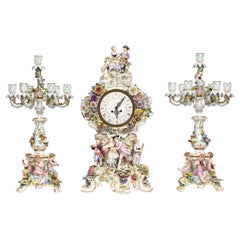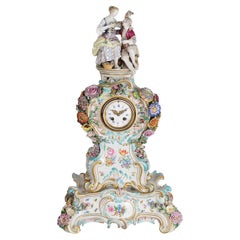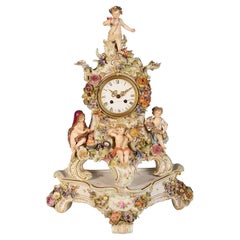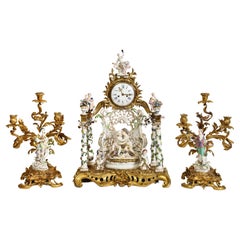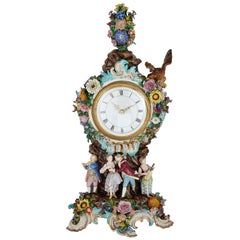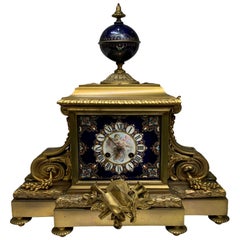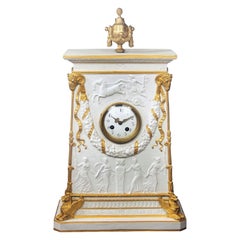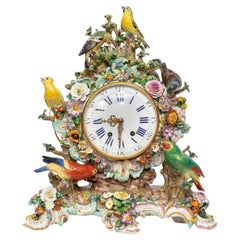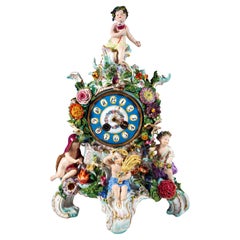Meissen Porcelain Clocks
Meissen Porcelain (Staatliche Porzellan-Manufaktur Meissen) is one of the preeminent porcelain factories in Europe and was the first to produce true porcelain outside of Asia. It was established in 1710 under the auspices of King Augustus II “the Strong” of Saxony-Poland (1670–1733), a keen collector of Asian ceramics, particularly Ming porcelain.
In pursuing his passion, which he termed his “maladie de porcelaine,” Augustus spent vast sums, amassing some 20,000 pieces of Japanese and Chinese ceramics. These, along with examples of early Meissen, comprise the Porzellansammlung, or porcelain collection, of the Zwinger Palace, in Dresden.
The king was determined, however, to free the European market from its dependence on Asian imports and to give European artisans the freedom to create their own porcelain designs. To this end, he charged the scientist Ehrenfried Walther von Tschirnhaus and aspiring alchemist Johann Friedrich Böttger with the task of using local materials to produce true, hard-paste porcelain (as opposed to the soft-paste variety European ceramists in the Netherlands, Germany, France, Italy and Spain had been producing since the late Renaissance). In 1709, the pair succeeded in doing just that, employing kaolin, or “china clay.” A year later, the Meissen factory was born.
In its first decades, Meissen mostly looked to Asian models, producing wares based on Japanese Kakiemon ceramics and pieces with Chinese-inflected decorations called chinoiserie. During the 1720s its painters drew inspiration from the works of Watteau, and the scenes of courtly life, fruits and flowers that adorned fashionable textiles and wallpaper. It was in this period that Meissen introduced its famous cobalt-blue crossed swords logo — derived from the arms of the Elector of Saxony as Arch-Marshal of the Holy Roman Empire — to distinguish its products from those of competing factories that were beginning to spring up around Europe.
By the 1730s, Meissen’s modelers and decorators had mastered the style of Asian ceramics, and Augustus encouraged them to develop a new, original aesthetic. The factory’s director, Count Heinrich von Brühl, used Johann Wilhelm Weinmann’s botanical drawings as the basis for a new line of wares with European-style surface decoration. The Blue Onion pattern (Zwiebelmuster), first produced in 1739, melded Asian and European influences, closely following patterns used in Chinese underglaze-blue porcelain, but replacing exotic flora and fruits with Western varieties (likely peaches and pomegranates, not onions) along with peonies and asters.
During the same period, head modeler Joachim Kändler (1706–75) began crafting delicate porcelain figures derived from the Italian commedia dell’arte. Often used as centerpieces on banquet tables and decorated to reflect the latest fashions in courtly dress for men and women, these figurines were popular in their day, and are still considered among Meissen’s most iconic creations. Kändler also created the Swan Service, which, with its complex low-relief surface design and minimal decoration is considered a masterpiece of Baroque ceramics.
The rise of Neoclassicism in the latter half of the 18th century forced Meissen to change artistic direction and begin producing monumental vases, clocks, chandeliers and candelabra. In the 20th century, Meissen added to its 18th-century repertoire decidedly modern designs, including ones in the Art Nouveau style. The 1920s saw the introduction of numerous animal figures, such as the popular sea otter (Fischotter), which graced an East German postage stamp in the 1960s. Starting in 1933, artistic freedom was limited at the factory under the Nazi regime, and after World War II, when the region became part of East Germany, it struggled to reconcile its elite past with the values of the Communist government. In 1969, however, new artistic director Karl Petermann reintroduced the early designs and fostered a new degree of artistic license. Meissen became one of the few companies to prosper in East Germany.
Owned by the State of Saxony since reunification, in 1990, Meissen continues to produce its classic designs together with new ones developed collaboratively with artists from all over the world. In addition, through its artCAMPUS program, the factory has invited distinguished ceramic artists, such as Chris Antemann and Arlene Shechet, to work in its studios in collaboration with its skilled modelers and painters. The resulting works of contemporary sculpture are inspired by Meissen’s rich and complex legacy.
Find a collection of authentic Meissen Porcelain on 1stDibs.
19th Century German Rococo Antique Meissen Porcelain Clocks
Porcelain
19th Century German Antique Meissen Porcelain Clocks
Porcelain
19th Century German Antique Meissen Porcelain Clocks
Porcelain
1760s German Louis XVI Antique Meissen Porcelain Clocks
Bronze
19th Century German Rococo Antique Meissen Porcelain Clocks
Porcelain
18th Century French Rococo Antique Meissen Porcelain Clocks
Porcelain
19th Century German Rococo Antique Meissen Porcelain Clocks
Porcelain
19th Century French Louis XV Antique Meissen Porcelain Clocks
Ormolu
19th Century German Antique Meissen Porcelain Clocks
Porcelain
1880s German Rococo Antique Meissen Porcelain Clocks
Porcelain
Mid-19th Century German Antique Meissen Porcelain Clocks
Porcelain
Late 19th Century French Empire Antique Meissen Porcelain Clocks
Bronze
Late 19th Century French Belle Époque Antique Meissen Porcelain Clocks
Bronze
Late 19th Century French Rococo Antique Meissen Porcelain Clocks
Enamel, Ormolu
Late 19th Century Antique Meissen Porcelain Clocks
Brass
Late 18th Century Austrian Rococo Antique Meissen Porcelain Clocks
Giltwood
19th Century German Neoclassical Antique Meissen Porcelain Clocks
Bronze
Mid-19th Century French Neoclassical Antique Meissen Porcelain Clocks
Marble, Slate
1880s German Baroque Antique Meissen Porcelain Clocks
Porcelain
Late 19th Century French Aesthetic Movement Antique Meissen Porcelain Clocks
Porcelain
19th Century French Rococo Antique Meissen Porcelain Clocks
Bronze
Late 19th Century French Louis XVI Antique Meissen Porcelain Clocks
Ormolu
Late 19th Century French Napoleon III Antique Meissen Porcelain Clocks
Bronze
1860s German Louis XVI Antique Meissen Porcelain Clocks
Porcelain
Late 19th Century German Rococo Antique Meissen Porcelain Clocks
Porcelain
1860s German Rococo Antique Meissen Porcelain Clocks
Porcelain
1880s German Rococo Antique Meissen Porcelain Clocks
Porcelain
1880s German Rococo Antique Meissen Porcelain Clocks
Porcelain
Early 20th Century German Rococo Revival Meissen Porcelain Clocks
Porcelain
1860s German Rococo Antique Meissen Porcelain Clocks
Porcelain
1850s German Rococo Antique Meissen Porcelain Clocks
Porcelain
19th Century German Rococo Antique Meissen Porcelain Clocks
Bronze
1880s German Baroque Antique Meissen Porcelain Clocks
Porcelain
Late 19th Century German Rococo Antique Meissen Porcelain Clocks
Porcelain
19th Century French Louis XVI Antique Meissen Porcelain Clocks
Ormolu
Meissen Porcelain clocks for sale on 1stDibs.
- 1stDibs ExpertApril 5, 2022To spot a fake Meissen, first, check the maker’s mark, generally found on the bottom of the porcelain. Meissen used a simple mark, so if you spot one that appears too embellished, it may be a fake. Shop a collection of properly vetted Meissen porcelain from some of the world’s top dealers on 1stDibs.
